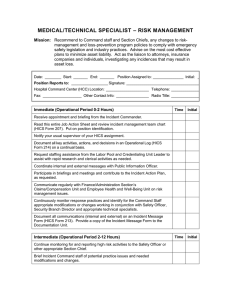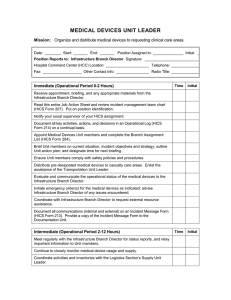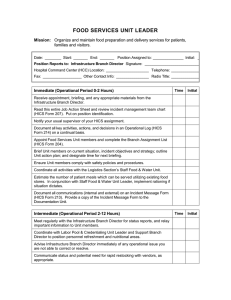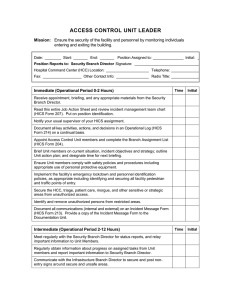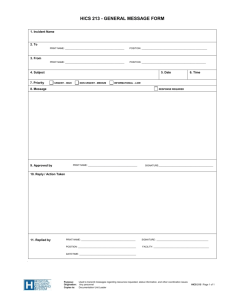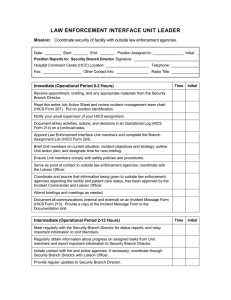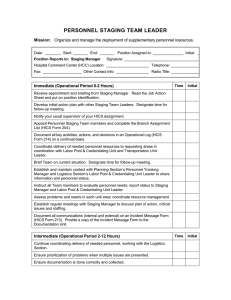OPERATIONS SECTION CHIEF
advertisement
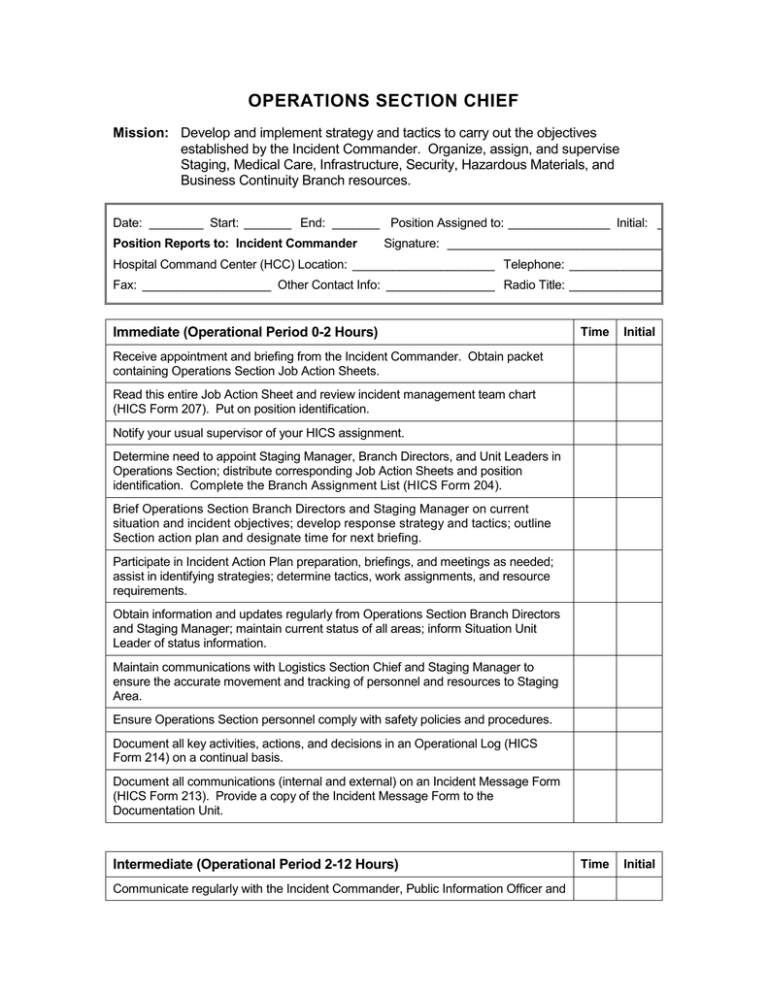
OPERATIONS SECTION CHIEF Mission: Develop and implement strategy and tactics to carry out the objectives established by the Incident Commander. Organize, assign, and supervise Staging, Medical Care, Infrastructure, Security, Hazardous Materials, and Business Continuity Branch resources. Date: ________ Start: _______ End: _______ Position Assigned to: _______________ Initial: ______ Position Reports to: Incident Commander Signature: _____________________________________ Hospital Command Center (HCC) Location: _____________________ Telephone: ___________________ Fax: ___________________ Other Contact Info: ________________ Radio Title: ___________________ Immediate (Operational Period 0-2 Hours) Time Initial Time Initial Receive appointment and briefing from the Incident Commander. Obtain packet containing Operations Section Job Action Sheets. Read this entire Job Action Sheet and review incident management team chart (HICS Form 207). Put on position identification. Notify your usual supervisor of your HICS assignment. Determine need to appoint Staging Manager, Branch Directors, and Unit Leaders in Operations Section; distribute corresponding Job Action Sheets and position identification. Complete the Branch Assignment List (HICS Form 204). Brief Operations Section Branch Directors and Staging Manager on current situation and incident objectives; develop response strategy and tactics; outline Section action plan and designate time for next briefing. Participate in Incident Action Plan preparation, briefings, and meetings as needed; assist in identifying strategies; determine tactics, work assignments, and resource requirements. Obtain information and updates regularly from Operations Section Branch Directors and Staging Manager; maintain current status of all areas; inform Situation Unit Leader of status information. Maintain communications with Logistics Section Chief and Staging Manager to ensure the accurate movement and tracking of personnel and resources to Staging Area. Ensure Operations Section personnel comply with safety policies and procedures. Document all key activities, actions, and decisions in an Operational Log (HICS Form 214) on a continual basis. Document all communications (internal and external) on an Incident Message Form (HICS Form 213). Provide a copy of the Incident Message Form to the Documentation Unit. Intermediate (Operational Period 2-12 Hours) Communicate regularly with the Incident Commander, Public Information Officer and Intermediate (Operational Period 2-12 Hours) Time Initial Time Initial Liaison Officer; brief regularly on the status of the Operations Section. Designate time(s) for briefings and updates with Operations Section leadership to develop or update the Section action plan. Ensure the following are being addressed: Section Staff health and safety Patient tracking Patient care Patient family support Interfacility transfers (into and from facility) Fatality management Information sharing with local EOC, public health, and law enforcement in coordination with the Liaison Officer Personnel and resource movement through Staging Area Documentation Initiate the Resource Accounting Record (HICS Form 257) to track equipment used during the response. Schedule planning meetings with Branch Directors and Staging Manager to update the Section action plan and demobilization procedures. Coordinate patient care treatment standards and case definitions with public health officials, as appropriate. Ensure that the Operations Section is adequately staffed and supplied. Coordinate personnel needs with Labor Pool & Credentialing Unit Leader, supply and equipment needs with the Supply Unit Leader, projections and needs with the Planning Section, and financial matters with the Finance/Administration Section. Ensure coordination with any assisting or cooperating agency. Extended (Operational Period Beyond 12 Hours) Continue to monitor Operations Section personnel’s ability to meet workload demands, staff health and safety, resource needs and documentation practices. Continue to maintain the Resource Accounting Record (HICS Form 257) to track equipment used during the response. Conduct regular situation briefings with Operations Section Branch Directors and Staging Manager. Address issues related to ongoing patient care: Ongoing patient arrival Bed availability Patient transfers Patient tracking Staff health and safety Mental health for patients, families, staff, incident management personnel Fatality management Staffing Staff prophylaxis Medications Extended (Operational Period Beyond 12 Hours) Time Initial Time Initial Medical equipment and supplies Personnel and resource movement through Staging Area Linkages with the medical community, area hospitals, and other healthcare facilities Documentation Ensure your physical readiness through proper nutrition, water intake, rest, and stress management techniques. Observe all staff and volunteers for signs of stress and inappropriate behavior. Report concerns to the Employee Health & Well-Being Unit. Provide for staff rest periods and relief. Upon shift change, brief your replacement on the status of all ongoing operations, issues, and other relevant incident information. Demobilization/System Recovery As needs decrease, return Operations Section staff to their usual jobs and combine or deactivate positions in a phased manner, in coordination with the Demobilization Unit Leader. Coordinate patient care restoration to normal services. Coordinate final reporting of patient information with external agencies through Liaison Officer and Public Information Officer. Work with Planning and Finance/Administration Sections to complete cost data information. Debrief staff on lessons learned and procedural/equipment changes needed. Upon deactivation of your position, brief the Incident Commander on current problems, outstanding issues, and follow-up requirements. Upon deactivation of your position, ensure all documentation and Operational Logs (HICS Form 214) are submitted to the Documentation Unit. Submit comments to the Incident Commander for discussion and possible inclusion in an after-action report; topics include: Review of pertinent position descriptions and operational checklists Recommendations for procedure changes Section accomplishments and issues Participate in stress management and after-action debriefings. Participate in other briefings and meetings as required. Documents/Tools Incident Action Plan HICS Form 204 – Branch Assignment Sheet HICS Form 207 – Incident Management Team Chart HICS Form 213 – Incident Message Form HICS Form 214 – Operational Log HICS Form 257 – Resource Accounting Record Hospital emergency operations plan Documents/Tools Hospital organization chart Hospital telephone directory Radio/satellite phone
